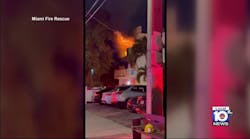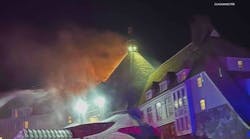When was the last time you emptied the pockets of your turnout gear? Maybe you had to have the gear cleaned or repaired, so you laid it out on the floor and took all of the "stuff" out of the pockets. Do you even know what is in your pockets? I've seen firefighters start to remove all of the tools and other items from a pocket and heard them say, "Wow, I forgot I was carrying that!" Let's look at some good and not-so-good ideas on what to carry in your pockets.
While teaching a recent self-contained breathing apparatus (SCBA) confidence course, my fellow instructors and I asked the firefighters to empty their pockets so we could all see just what each of them was carrying. The reason we do this is the first lesson of the class: Don't carry too much stuff!
We already wear heavy turnout gear and heavy SCBA and carry heavy tools. We should be trying to lighten the load rather than carrying another couple of pounds of equipment that we don't even know is in our pockets. Minimize the number and size of the items in your pockets to limit both the additional weight and bulk in your gear.
So what did we find lying on the floor as the pockets were emptied?
- Wire cutter/pliers — This is an excellent tool for a firefighter to carry. It can be used to cut or snip entangling wires and to loosen a nut or screw that can be grasped with the tool. Don't, however, carry the 12-inch cutters. Find a small, lightweight and well-built cutter for this job.
- Knife — This is another great tool to carry. At one time or another, we will all need to cut something. It may be a rope that has snagged on our SCBA or it may be a piece of material that must be cut to expose smoldering material. A razor knife is another variation of the standard knife with a blade, but you can change the blade if necessary. Again, carry a small, lightweight version, not an Amazon jungle sword.
- Rope — There are two types of rope that you may have. A utility rope is for general use, such as tying up a smoldering mattress before you remove it from the building or securing a nozzle to a fencepost during an outside operation. This rope should be relatively short (15 feet) and lightweight. The other rope you may have is a bailout, or escape, rope. This is a much more substantial rope that is reserved for life-saving escape purposes. This rope should be carried in a separate pocket where it can be kept clean and dry.
- Flashlight — Each of us should carry at least two flashlights. Yes, TWO! If you have only one flashlight and the battery dies or the light malfunctions, you are alone in the dark. Most of us carry or wear or a primary light and the secondary, or backup, light can be carried in a pocket where it will stay dry and fairly protected from damage and ready for duty when needed. Once again, I must remind you to keep your lights small and lightweight.
- Chocks — Every firefighter should have a chock or two in one of their pockets. Chocks can be used to hold doors open or closed, to stop the flow of water from a sprinkler head, and to pry or wedge open just about anything that it can be driven into. For engine firefighters, the primary use of a chock is to keep doors from closing over a dry hoseline that is stretched through the doorway. Always have a chock.
- Gloves — Some of us like to carry an extra pair of gloves. It may be a pair of bulky fire gloves or a lighter or thinner pair that can be used when working with tools at non-fire emergencies.
- Hose strap — Again, this is an engine firefighter's tool. A hose strap can be used to secure a hoseline from sliding down a stairway or from being pulled out of a window. The strap also can be used to secure to a hoseline that will be used in one spot for a long time, relieving the engine firefighters from having to work at holding it in one spot.
- Screwdriver — Like the other tools, try to find a small and versatile screwdriver. The best would be one that holds several different tips in the handle so it can be used for different types and sizes of screws.
- Spanner wrench — A spanner wrench is a standard fire service tool that all firefighters should carry. It is primarily an engine company tool, but the truck company can tighten a coupling or help to break one after the fire, if necessary.
Are there more tools or pieces of equipment that you may carry in your pockets? Yes, but not many more, because we are trying to stay light and versatile. We want to be able to move quickly, slide through tight spaces and get the most out of our limited air supply. We can't do that with 20 hand tools, four ropes, three pieces of webbing, two pairs of goggles and the kitchen sink.
I've listed nine items here. I'll let you carry 10.
JOHN J. SALKA Jr., a Firehouse® contributing editor, is a 28-year veteran battalion chief with FDNY, the commander of the 18th battalion in the Bronx. Salka has instructed at several FDNY training programs, including the department's Probationary Firefighters School, Captains Management Program and Battalion Chiefs Command Course. He conducts training programs at national and local conferences and has been recognized for his firefighter survival course "Get Out Alive." Salka co-authored the FDNY Engine Company Operations manual and wrote the book First In, Last Out — Leadership Lessons From the New York Fire Department. He also operates Fire Command Training (www.firecommandtraining.com), a New York-based fire service training and consulting firm.





